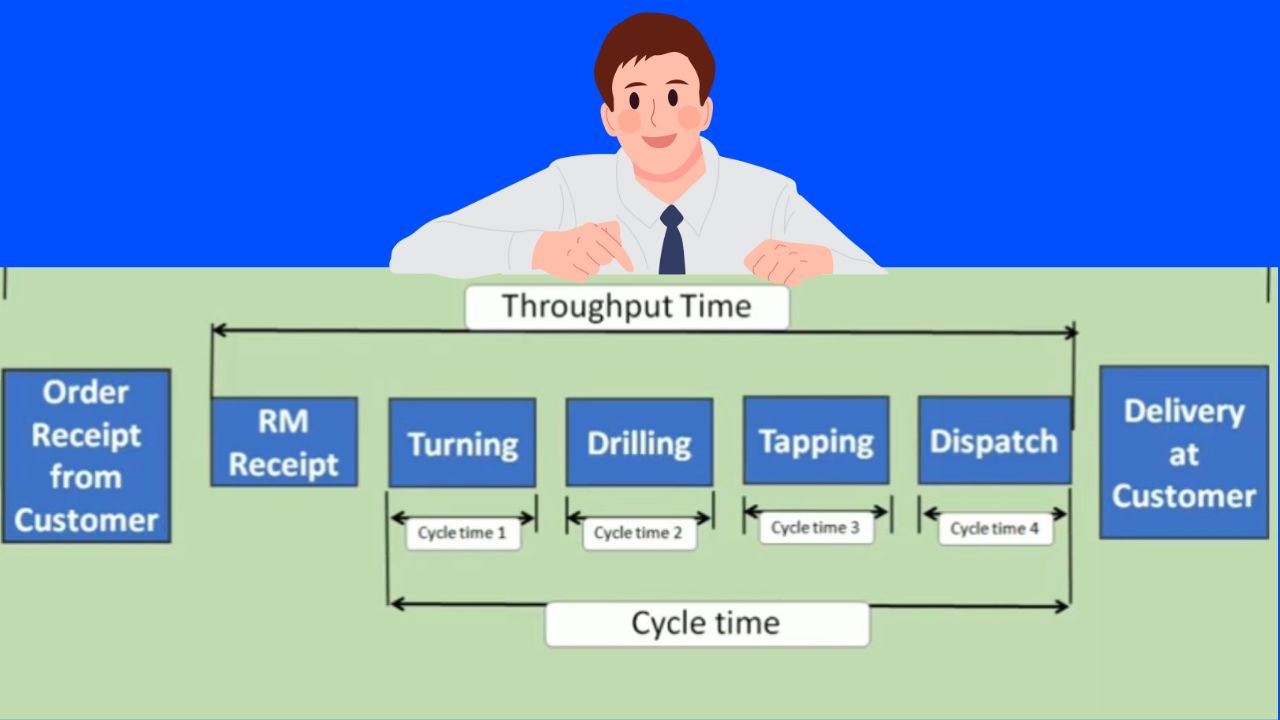Have you wondered why some processes seem to flow effortlessly while others get bogged down, causing delays, and inefficiencies? The answer lies in how you measure throughput time vs cycle time within your operations.
Whenever you are optimizing manufacturing processes there are 2 critical time metrics you need to consider i.e. Throughput Time and Cycle Time. As a Lean implementor, it is important to understand the differences between these 2 metrics for streamlining processes.
In this article, I will discuss the definition, differences, advantages & disadvantages, and practical implications of throughput time vs cycle time. Whether you are new to Lean or already working as a Lean practitioner, understanding these metrics is useful.
Are you ready to understand throughput time vs cycle time differences? Then let’s get started…
Importance of understanding Time metrics in Lean Manufacturing
Before understanding the throughput time vs cycle time differences let me tell you the importance of time metrics in Lean manufacturing.
Generally, Lean Practitioner talks more about the bigger Lean tools but along with that these time metrics are also key elements of Lean.
Time metrics provide a clear and quantifiable way to assess and improve the efficiency and effectiveness of production processes.
By optimizing these metrics companies can easily reduce waste, improve process quality, and ultimately increase customer satisfaction.
Time metrics such as cycle time, throughput time, lead time, and takt time help identify areas where time is wasted such as waiting, excessive movement, or overproduction.
By understanding these metrics you can target specific areas for improvement and streamline processes. These metrics provide a baseline for measuring the efficiency of production processes.
By tracking these metrics, you can identify bottlenecks and inefficiencies that slow down production. For example, longer cycle times may indicate that certain steps in the process are taking too long.
Time metrics help companies manage their resources more effectively. By understanding the time required for each step in the production process, companies can allocate resources more effectively, avoid overproduction, and reduce inventory levels.
This leads to cost savings, and better utilization of labor, equipment, and materials. With the proper management of different time metrics, companies can deliver services or products on time ultimately increasing customer satisfaction.
As you know Lean Manufacturing is built on the principles of continuous improvement. Time metrics provide a quantifiable way to measure the impact of improvement initiatives.
By tracking changes in metrics over time, companies can assess the effectiveness of their efforts, set realistic goals, and make data-driven decisions for further improvements.
You know that effective decision-making is important for continuous improvement initiatives. Time metrics provide valuable data that can guide decisions related to production scheduling, capacity planning, and process optimization.
I will discuss different time metrics in the upcoming article but today’s focus is on throughput time vs cycle time differences. Let’s understand individual time metrics first and then I will compare these two time metrics by considering different parameters.
What is Throughput Time?
The throughput time is an important time metric in Lean manufacturing. It represents the total time required to convert raw materials into finished products, from the moment production begins to when the product is completed and ready for delivery.
This includes every stage from initial input to final output. Basically, it measures the efficiency of a production system by measuring how long it takes for an item to pass through the entire production process.
By understanding and managing the throughput time effectively, manufacturers can streamline their processes, reduce delays, and improve overall efficiency. Before understanding the throughput time vs cycle time differences, let’s look at the key components of throughput time.
Key components of Throughput Time:
- Processing time: The time spent actively working on the product during each stage of production. For instance, if a machine is busy turning raw materials into a component, the duration it operates on that task is included here.
- Queue time: The time a product spends waiting before the next stage of production. For example, if a component is finished but has to wait in a queue before being inspected that waiting period added to the throughput time.
- Setup time: The time required to prepare equipment or workstations before actual production can start. If changing matching settings or tools is necessary for producing different items, this setup time is part of the throughput time.
- Inspection time: The time spent checking the product for quality. If a production needs to be tested or inspected after certain stages, this time is included in the throughput calculation.
- Transport time: The time taken to move products between different stages of the manufacturing process. For example, the time required to transport finished parts from the assembly line to the packaging area is part of throughput time.
Examples of Throughput Time:
- In car production, throughput time includes the time required for assembling various parts such as the engine, chassis, different components of the car, and interior/exterior body.
- If a car takes 10hrs to assemble another hour for inspection and 30 minutes for transport to the next station, the total throughput time would be the sum of these durations,
- For a smartphone manufacturing company, throughput time might involve the assembly of electronic components, which could take several hours.
- Adding in the time for testing each phone, and the time it takes to transport the phones between assembly stages gives the total throughput time.
- In a food manufacturing plant, throughput time includes the time it takes for preparing ingredients, cooking, packaging, and quality checks.
- If a batch of food products takes 5 hours to process, including setup and transport times, then 5 hours is the throughput time.
What is Cycle Time?
The next time metric is Cycle time which measures the total time it takes to complete one unit of production from start to finish. This includes all stages of the production process, from the initial input of raw materials to the final output of the finished product.
Cycle time focuses especially on the production phase, the goal of lean is to minimize cycle time to increase efficiency and throughput. The lower the cycle time higher the process is streamlined.
This is a crucial metric for assessing the efficiency of production processes, as it directly influences the rate at which products are produced and delivered to customers. Before comparing throughput time vs cycle time, let’s look at the key components of cycle time.
Key components of Cycle Time:
- Processing time: The actual time spent working on a product. It includes activities like machining, assembling, painting, or any other operation that directly adds value to the product.
- Setup time: The time required to prepare equipment or processes before the actual production begins. This could involve changing tools, adjusting settings, or cleaning machines.
- Waiting time: The time a product spends waiting for the next step in the process. This could be due to equipment downtime, bottlenecks, or scheduling delays.
- Movement time: The time taken to move materials, components, or products from one station to another within the production area.
- Inspection time: Time spent checking the quality of the product to ensure it meets the required standards. This could include both in-process checks and final inspection.
Examples of Cycle Time:
- In a car assembly line, cycle time includes all processes from assembling the chassis, installing the engine, and painting the car, to the final inspection. If it takes a total of 8 hrs to produce one car from start to finish that is the cycle time.
- In smartphone manufacturing, cycle time would cover everything from assembling the circuit board, installing the software, and adding the casing, to quality testing. If the entire process takes 4hrs per phone, that’s the cycle time.
- Consider a bakery producing loaves of bread. The cycle time includes mixing ingredients proofing the dough, baking, cooling, slicing, and packaging. If the total time from mixing to packaging is 3hrs, then the cycle time for one loaf is 3hrs.
Differences: Throughput Time vs Cycle Time
Till now I discussed the fundamentals of throughput and cycle time along with their examples. Let’s understand the throughput time vs cycle time differences by considering all the important parameters.

| Parameter | Throughput Time | Cycle Time |
| Definition | The total time taken for a product to move through the entire production process, from start to finish. | The time taken to complete one unit or cycle of a specific process or task. |
| Scope | Includes all stages of the process, such as waiting, processing, inspection, and transportation. | Focuses solely on the time required to perform the actual task or operation. |
| Measurement Focus | Measures the total duration, including delays and non-value added time. | Measures only the time spent on value-added activities. |
| Goal | To minimize the overall time from order delivery, enhancing customer satisfaction. | To reduce the time taken to perform specific tasks, increasing process efficiency. |
| Use case | Useful for understanding the entire process flow and identifying bottlenecks. | Useful for analyzing and improving specific steps in a process. |
| Impact on Inventory | Longer throughput time often results in higher work-in-progress (WIP) inventory. | Shorter cycle time leads to quicker turnover and less inventory. |
| Key Considerations | Consider all factors affecting the entire process including external factors. | Focuses on internal process efficiency and specific task execution. |
| Relation to Lead Time | Throguhtput time is often equated with Lead Time, but they are a little bit different. | Cycle time is a component of throughout time, contributing to Lead Time. |
| Common Tools that use time metrics | Value stream mapping, Process flow analysis | Time study, Process mapping |
| Examples | Time from receiving raw materials to shipping the finished product. | Time to assemble a single unit of product on a production line. |
Now you understand the throughput time vs cycle time differences, but you know we discussed the theory part here you will understand its real use in production when you learn this under the guidance of a Lean specialist.
For that I would recommend you to join EALSS Academy’s Lean Expert with 38 Lean Tools live training and 3 certification programs to learn the time metrics in Lean manufacturing with practical examples under the guidance of an expert.
Just click on the above link register for the program and join the official group of EALSS Academy. You can watch 1hrs FREE session recording inside to understand the instructor’s teaching style.
After joining the group support team will provide you with complete details about how to enroll in this program and get certified in 3 levels of Lean. ( Check out – All You Need to know about Lean Expert Live training program)
Conclusion
Understanding the throughput time vs cycle time differences is crucial for optimizing manufacturing processes in a Lean environment. Both metrics play a pivotal role in identifying bottlenecks, improving efficiency, and meeting customer demands effectively.
As a Lean implementer when you understand the throughput time vs cycle time differences, you can regularly monitor and analyze these two metrics to maintain lean practices and foster a proactive approach to identify and address inefficiencies before it’s too late.
Even though the throughput time vs cycle time differences say that these two time measures different aspects of production, their synergy in Lean manufacturing ensures the leaner and customer-focused manufacturing process optimizations.
If you found this article useful then please share it in your network and subscribe to get more such articles every week.



